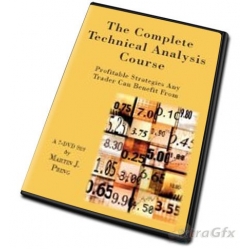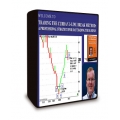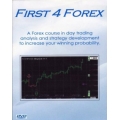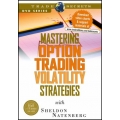Martin Pring - The Complete Technical Analysis Course with Trend Catcher system(bonus)
 Click to enlarge |
|
The Complete Technical Analysis Course
Lesson 1 - The Building Blocks of Technical Analysis
Lesson 2 - Introduction to Classic Price Patterns
Lesson 3 - One- and Two-bar Price Patterns
Lesson 4 - Introduction to Basic Momentum Principles
Lesson 5 - Introducing the KST
Lesson 6 - Applying Technical Analysis to the Theory of Contrary Opinion
Lesson 7 - Practical Trading Tactics Applied to the Marketplace
Published:
In his usual style, Martin explains both the strengths and weaknesses of the techniques he describes in each 75+ minute lesson. Why not share this experience at a fraction of the cost of attending a seminar by purchasing one or more titles in his new series? And as with all the “Pring” videos, the presentation is full of actual examples in the market place.
Lesson 1 - The Building Blocks of Technical Analysis
This presentation is a basic introduction for anyone new to the fascinating subject of technical analysis.
![]() Technical Analysis - What it is. Why prices are determined by psychology and how technical analysis can help interpret market psychology.
Technical Analysis - What it is. Why prices are determined by psychology and how technical analysis can help interpret market psychology.
![]() Trends - What is a trend? How long do they last? How do they integrate?
Trends - What is a trend? How long do they last? How do they integrate?
![]() Arithmetic vs. Logarithmic Scaling - Technical analysis requires charts and the choice of scaling them can be very important. This section explains the difference between these techniques and why one is superior over the other.
Arithmetic vs. Logarithmic Scaling - Technical analysis requires charts and the choice of scaling them can be very important. This section explains the difference between these techniques and why one is superior over the other.
![]() Volume - Observations on volume interpretation.
Volume - Observations on volume interpretation.
![]() Peak and Trough Analysis - Why it’s probably the most important technical tool. How is it applied in the market place and integrated with other indicators.
Peak and Trough Analysis - Why it’s probably the most important technical tool. How is it applied in the market place and integrated with other indicators.
![]() Support and Resistance - The concepts defined. Rules for determining where potential support and resistance areas might lie are given along with guidelines for determining their potential significance.
Support and Resistance - The concepts defined. Rules for determining where potential support and resistance areas might lie are given along with guidelines for determining their potential significance.
![]() Trendlines - A to Z introductory primmer on trendlines, how to draw and interpret them.
Trendlines - A to Z introductory primmer on trendlines, how to draw and interpret them.
![]() Price Patterns - Basic principles of price pattern interpretation using rectangles and head and shoulders patterns as examples. Determining the significance of individual patterns and identifying when they have failed is also covered.
Price Patterns - Basic principles of price pattern interpretation using rectangles and head and shoulders patterns as examples. Determining the significance of individual patterns and identifying when they have failed is also covered.
Lesson 2 - Introduction to Classic Price Patterns
This session introduces you to the most common price patterns. Building on the knowledge leaned from the previous DVD, you will be in a better position to understand how patterns are formed and the psychology behind them. If you can rationalize why a pattern is being formed, you will be in a better position to anticipate when a breakout might turn out to be a whipsaw, and how you can protect against this. This session also explains how price objectives are determined from patterns. A large number of market place examples in all time frames is generously dispersed throughout the presentation. The individual formations covered are:
Rectangles
Head and shoulders tops and bottoms
Triangles
Double tops and bottoms and triple formations, including “Chinese” and “Lucky Seven” double bottoms.
Broadening formations, broadening wedges and giant wedges
Cup and Handle formations
Lesson 3 - One- and Two-bar Price Patterns
Prices in any freely traded market are determined by psychology. One- and two-bar price patterns represent classic examples of how these emotional characteristics are reflected in the charts.
![]() The great advantage of these extremely reliable patterns is that they signal reversals in trend at a very early stage, both on the intraday and daily charts..
The great advantage of these extremely reliable patterns is that they signal reversals in trend at a very early stage, both on the intraday and daily charts..
![]() The presentation also explains that not all patterns are created equal. Pring gives you a checklist for determining the significance of each type.
The presentation also explains that not all patterns are created equal. Pring gives you a checklist for determining the significance of each type.
![]() Patterns covered include the “Big Seven”,
Patterns covered include the “Big Seven”,
-
Outside bars
-
Inside bars
-
Two-bar reversals
-
Exhaustion bars
-
Key-bar reversals
-
Pinocchio bars
-
Three-bar reversals
Lesson 4 - Introduction to Basic Momentum Principles
Market momentum provides a powerful dynamic to any trading arsenal. In this presentation Martin Pring explains that momentum is a generic term embracing a host of oscillators. Each is subject to the same rules of interpretation in some form or another. Key techniques are explained in detail.
![]() They are —
They are —
-
Overbought / oversold
-
Divergences
-
Oscillator characteristics in bull and bear markets
-
Trendlines applied to momentum
-
Price patterns applied to momentum
-
Moving averages applied to momentum
![]() Individual oscillators that are explained include the rate-of-change, RSI, and MACD. Practical application of these indicators is demonstrated with a host of market place examples.
Individual oscillators that are explained include the rate-of-change, RSI, and MACD. Practical application of these indicators is demonstrated with a host of market place examples.
Lesson 5 - Introducing the KST
The KST is a momentum indicator invented by Martin Pring. It is a summed rate of change that combines several time spans into one indicator. It is designed so that the oscillations correctly reflect the up and down waves of the trend being monitored. However, the inclusion of short-term time frames in the indicator’s construction allow it to turn more quickly than many other indicators, thereby warning of a trend reversal on a more timely basis. Topics covered include:
-
The Rationale
-
The Long-term KST (primary trend)
-
The Short (daily) and Intermediate (weekly) KSTs
-
Integrating the Three Trends
-
The Intraday KST
-
Using the KST with Relative Strength
Oh, and you’ll also find out what KST stands for and find the various formulas, including those for MetaStock users in the downloadable .PDF file included on the presentation.
Lesson 6 - Applying Technical Analysis to the Theory of Contrary Opinion
In recent years, the theory of Contrary Opinion has become very popular, but also misunderstood. In this presentation Martin explains why this is so, and how this art can be profitably applied to the marketplace. He takes you through a step-by-step process of how to form a contrary opinion. He also demonstrates why it is difficult to take a contrary position and how to overcome this hurdle.
Going against the crowd is usually the correct thing to do, but it can be frustratingly (and unprofitably) early, as many bears found out to their chagrin in 1927 and 1928. Since charts reflect crowd psychology, technicians are in a unique position to utilize the art of contrary thinking and create razor sharp timing. A key part of this presentation explains techniques for integrating the two. This presentation wraps up by describing, and debasing, seven popularly held market myths.
Lesson 7 - Practical Trading Tactics Applied to the Marketplace
Lots of time is spent on learning the principles of technical analysis, but precious little is devoted it its practical application in the marketplace. In this presentation Martin shows you numerous techniques that you can apply for more profitable trading.
![]() He sets out by explaining, with the aid of examples, why the first objective of any trader should be to avoid major losses, rather than trying to make major gains.
He sets out by explaining, with the aid of examples, why the first objective of any trader should be to avoid major losses, rather than trying to make major gains.
![]() One technique for achieving this goal is the correct placement of stops below support and above resistance. Rules for assessing potential support/resistance zones are discussed using the following technical tools -
One technique for achieving this goal is the correct placement of stops below support and above resistance. Rules for assessing potential support/resistance zones are discussed using the following technical tools -
-
Gaps
-
Emotional Points
-
Trendlines
-
Moving Averages
-
Retracement moves
-
Previous highs and lows
![]() Technicians would love to know ahead of time whether the market they are trading is likely to trend or become a trading range. Unfortunately, this is not possible. However, Martin explains a trading plan that can deals profitably with both environments.
Technicians would love to know ahead of time whether the market they are trading is likely to trend or become a trading range. Unfortunately, this is not possible. However, Martin explains a trading plan that can deals profitably with both environments.
![]() Finally, since the biggest obstacle to any trader is emotion, Martin offers ten tips to better overcome your natural tendencies and become a more objective trader.
Finally, since the biggest obstacle to any trader is emotion, Martin offers ten tips to better overcome your natural tendencies and become a more objective trader.
Trend Catcher system
These are the steps that you need to follow closely to identify a BUY setup explained in the manual. If you stick to these rules, you will end up with green pips most of the times. The major problem occurs when you try to burn one of the rules.
The Takeprofit and Stoploss is at your own discretion. These values depends on the charts on which you are working on. For example on the H1 chart, you should aim at a lower TP( 60pips) and on the H4, you can aim at a higher TP( 100pips)
Template,indicator and manual includes
Receive this special offer as free product when you purchase "Martin Pring - The Complete Technical Analysis Course"
The reason you should choose us?
-We sell premium FX product of the world's most popular, We are always improving the quality of the best service
-We work 100% reputable and high sense of responsibility.Entertain call or message in timely manner(via whatsapp +60179843428 or email)
-Accept payment via PayPal, Maybank2u,cimb click 100% Safe, Comfortable, Simple and Fast.
-Reasonable price(as low as $2!), Support enthusiasm.
-Receive product in the same day payment made.Immediate download to your computer!
Completing units:
![]() Martin Pring - The Complete Technical Analysis Course
Martin Pring - The Complete Technical Analysis Course
Delivery to your PayPal email address within 24 Hours of payment confirmation.
Market Sales Price: $1199,but we sell lot more lower than that to share the opportunity with you!
Our Policies
A. Product Quality
- We ensure that the quality of the course is good, and we update them regularly to help you keep update.
- If there is a problem you can not use, please let us know so we can fix it soon or if there is any notification, we will inform you immediately.
B. Shipping Method
- After receiving your payment, we will send you a link to access and download the course. If our team is not in the office, please wait for us about 8 hours to come back.
C. Refund Policy
We do not accept refund after you got the link and download the course.
We will refund your money in case of:
- Item is not as described
- Item doesn’t work the way it should
- Item support extension can’t used
Serving Professional Traders Since 2008
Once purchased I will email you the files within 20 minutes and not more than 48 hours to your email, if there a delay, please be patience receiving your files
Your Review: Note: HTML is not translated!
Rating: Bad Good
Enter the code in the box below:

 Categories
Categories Information
Information Specials
Specials




-38x38.jpg)

-38x38.jpg)
-38x38.jpg)
-38x38.jpg)
-38x38.jpg)
-38x38.jpg)

-38x38.jpg)



-38x38.jpg)


-38x38.jpg)
-38x38.jpg)
-38x38.jpg)
 Featured
Featured

























 Shopping Cart
Shopping Cart Bestsellers
Bestsellers






-38x38.jpg)































-38x38.jpg)












































